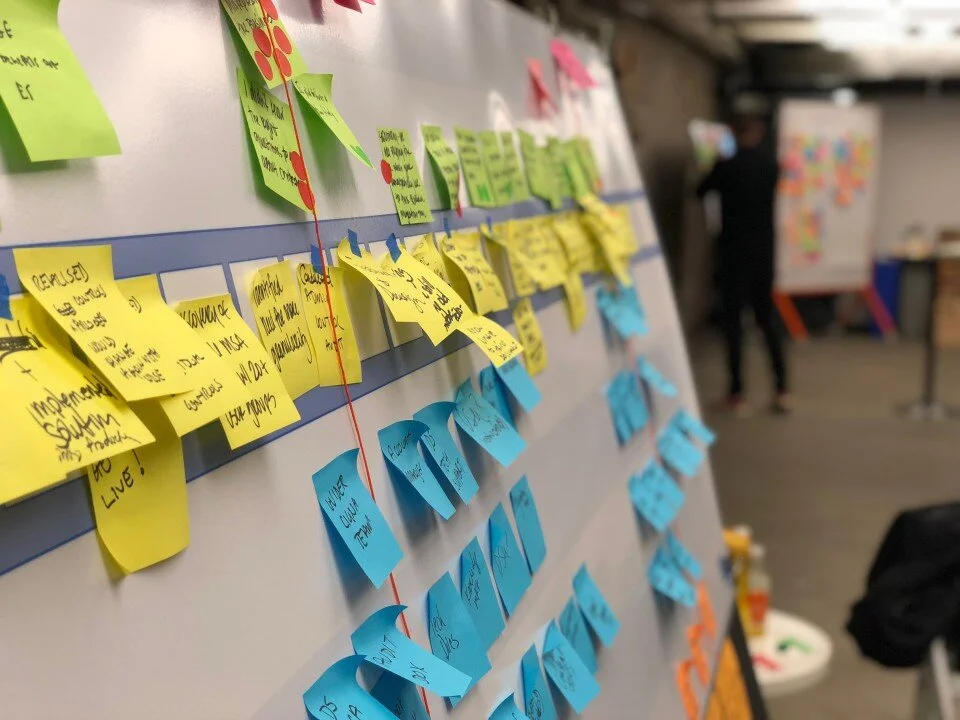If you landed here first, check out the first post in this series: "Journey mapping secrets revealed."
It’s a core belief at my firm, Method Garage, that journey mapping must be done with stakeholders and not for stakeholders. By collaboratively mapping the current state experience with stakeholders, my business partner Justin Zacks and I create stakeholder buy-in and a shared passion to solve customer opportunities.
The two objectives for this phase are straightforward. First, we must uncover a current state journey map that highlights top customer needs and the moments that matter most - to the customer and the business. Second, we need to build excitement and momentum amongst the stakeholders to ensure the project reaches the finish line. So, how do we do it? We've found that incorporating a workshop component into your journey mapping initiative, when done right, can make all of the difference. Here are our top secrets to help you knock your next journey mapping workshop out of the park.
Secret 1 – Be strategic about who’s in the room
When you’re putting together the workshop where you’ll develop the current state journey map, it’s helpful to think a step or two ahead. You should already be thinking in terms of broad representation from across the client organization—that will ensure a healthy mix of diverse perspectives. But you should also consider the people and silos who’ll be most involved in moving your work forward. Who will be tasked with putting your learnings into practice? And who are the higher-level stakeholders who’ll control the levers of change along the way? The workshop can be your best opportunity to get the gears of change management into motion, so make sure you invite the people whose buy-in you’re going to need down the line.
Secret 2 – Make every minute count
Workshop facilitation should feel effortless to participants—you’re confident, relaxed, and highly organized. They’ll never know how much you’re agonizing over every minute that ticks away. Because that’s what you have to do—plan every beat beforehand with meticulous attention to detail, and then keep it tight, on-track, and packed with discoveries and insights. For one thing, you’ve got a lot of human capital in that room—senior people who’ve made time in their schedule, and perhaps even traveled to get there. That’s a leap of faith in itself, and you want them to feel like the investment was worth making. Beyond that, a high-value workshop can be highly affirming and inspiring for participants at every level. People should leave feeling like it was the most amazing two days of their lives. That energy will carry the whole project forward.
Secret 3 – Get the customer’s voice into the workshop
In the world of design thinking, everything begins with the customer. It’s their perspective that matters most. So why would you ever hold a workshop without letting their voice be heard? The gold standard would be to fly in a few of your interviewees and put them at the table; if cost is a factor, you can conference them in by videoconference at key points in the workshop. Remember those recordings you made in phase 1? Play them back at length for workshop participants —not just the sound bites, but extended exchanges that give real depth and insight into the customer’s experience. Don’t bother with interview quotes taped to the wall; you might as well use a poster of a kitten hanging from a branch.
As I’ve said before, the customer’s voice is the most powerful and compelling way to get the attention of stakeholders. Use it now to deliver the aha moments you need stakeholders to hear.
Secret 4 – Design for shareability
When participants get back to the office after the workshop, they’ll be eager to share the experience with their colleagues, and their teams will want to know what it was all about. Make that exchange easy by creating assets for people to take with them. At Method Garage we often provide a “Recap” deck of eight or nine picture-heavy, high-level slides on the work we did together. Audio comes in handy here as well—provide customer interview files and encourage participants to share them widely. It’ll help build excitement and alignment, and extend the impact of the workshop beyond those who were able to attend in person.
By the end of the current state journey mapping workshop, you’ve got a clear sense of how things stand now. To drive real business impact, the next step is to build on this understanding to make things better moving forward. In my next post, we’ll look at phase 3: aligning teams around a future vision that delivers real results.


